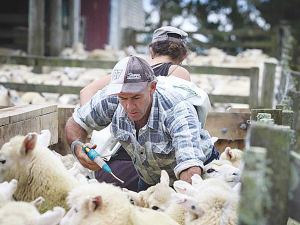NZ scientists make breakthrough in Facial Eczema research
A significant breakthrough in understanding facial eczema (FE) in livestock brings New Zealand closer to reducing the disease’s devastating impact on farmers, animals, and rural communities.
 AgResearch scientist Dave Leathwick says there is a degree of conjecture and uncertainty about the benefits of pre-lambing drenching.
AgResearch scientist Dave Leathwick says there is a degree of conjecture and uncertainty about the benefits of pre-lambing drenching.
AgResearch scientist Dr Dave Leathwick believes there’s a strong case for thinking twice about the practice that is routinely carried out by around 80% of sheep farmers as part of their pre-lamb animal health treatments.
Speaking on a recent webinar, Leathwick says pre-lambing drenching is ingrained in farmers’ psyche, despite there being a degree of conjecture and uncertainty about the benefits of the practice.
He says trials first carried out in the 1960s and 1970s showed inconsistent benefits from drenching ewes, either pre- or post-lambing, and subsequent trials have reinforced these findings.
The practice also increases the risk of selecting for drench resistant parasites, particularly when long-acting products are used.
Seven years ago, AgResearch helped two groups of farmers carry out 14 anthelmintic trials on eight farms in the Wairarapa over two years. The trials were looking at several variables, including the financial benefits of a pre-lamb treatment with a long-acting drench and what treatments were the most effective.
A cost-benefit analysis of the treatments was carried out and showed 47% of the treatments to ewes resulted in a net financial loss, some as much as $10/ewe.
This was because some of the treated ewes in the trials weaned fewer lambs than the un-drenched cohort.
A follow-up study looking specifically at whether there was a survival advantage or disadvantage to drenching ewes pre-lamb was carried out across New Zealand. While, as before, there was a wide variation between treated and untreated ewes and between farms, on average there was no advantage or disadvantage to lamb survivability.
But the question remained about whether a drench treatment could result in lamb deaths persisted. As part of the investigation into this question, Leathwick’s group have shown that Macrocyclic Lactone (ML) drenches are passed to the young lamb in the ewe’s milk and that Moxidectin can be transferred across the placenta and enter the foetus.
“We don’t know yet whether these findings are important or not, but it seem to be an issue worthy of further study.”
One of the more surprising findings of the Wairarapa trials was the lack of correlation between Body Condition Score and anthelmintic treatment or Faecal Egg Counts.
Body Condition Score was largely irrelevant in terms of the scale of the response to treatment.
Scientists found that over the period from pre-lambing to weaning, a proportion of the ewes increased in body condition, a proportion lost body condition, and some stayed the same irrespective of drench treatments.
Leathwick says there was no evidence to show that skinny ewes were affected by parasites any more than fat ewes. And they could not show that there was any greater benefit to pre-lamb drenching ewes in low body condition.
“However, there may be other benefits, such as ewe survival over winter that we did not measure” he cautioned.
In another, more recent trial, AgResearch found a short-lived liveweight response to drench capsules and injectables in low body condition score ewes. However, most of this advantage did not persist through until weaning. He cites several previous New Zealand studies which have shown the same thing. The benefit measured at the time these long-acting drenches cease working is reduced with time afterwards as the untreated ewes tend to catch-up.
Work is on-going, but Leathwick urges farmers to reconsider what they are getting from their pre-lamb drench programme.
Legal controls on the movement of fruits and vegetables are now in place in Auckland’s Mt Roskill suburb, says Biosecurity New Zealand Commissioner North Mike Inglis.
Arable growers worried that some weeds in their crops may have developed herbicide resistance can now get the suspected plants tested for free.
Fruit growers and exporters are worried following the discovery of a male Queensland fruit fly in Auckland this week.
Dairy prices have jumped in the overnight Global Dairy Trade (GDT) auction, breaking a five-month negative streak.
Alliance Group chief executive Willie Wiese is leaving the company after three years in the role.
A booklet produced in 2025 by the Rotoiti 15 trust, Department of Conservation and Scion – now part of the Bioeconomy Science Institute – aims to help people identify insect pests and diseases.

OPINION: The release of the Natural Environment Bill and Planning Bill to replace the Resource Management Act is a red-letter day…
OPINION: Federated Farmers has launched a new campaign, swapping ‘The Twelve Days of Christmas’ for ‘The Twelve Pests of Christmas’ to…